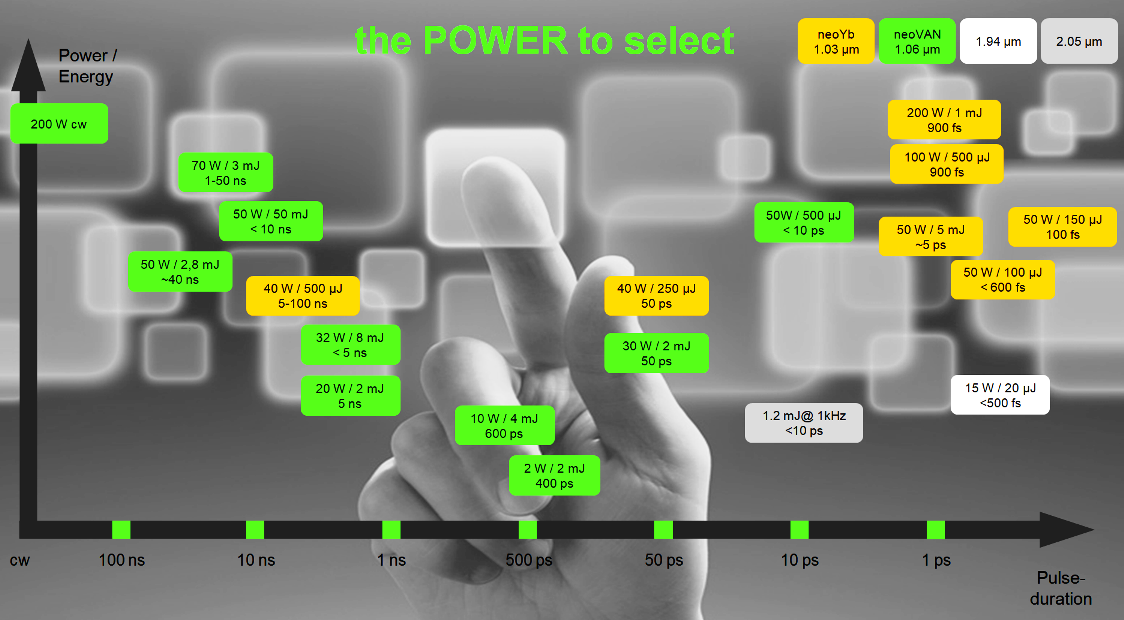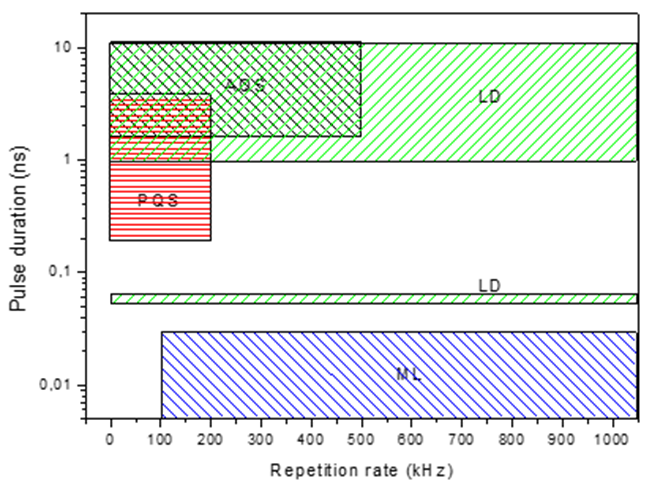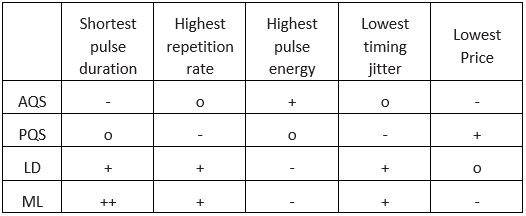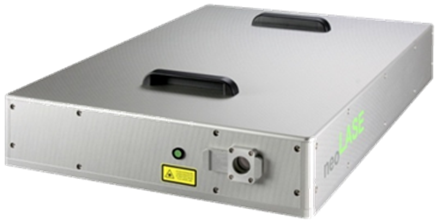
Introduction:
This white paper will give an overview of different seed laser technologies to be integrated in the neoMOS laser platform.
neoMOS: Flexible Laser Platform
The neoMOS laser systems are based on a MOPA (Master Oscillator Power Amplifier) architecture that combines our amplifier modules with different oscillators, also called seed lasers. This technology enables us to address a variety of different laser parameters and pulse durations from the same laser platform. Different seed laser technologies are available for the pulse duration range of a few nanoseconds down to about 100 fs. Depending on the required pulse duration, active (AQS) and passive q-switched (PQS) oscillators, modulated laser diodes (LD), or pulse-picked mode-locked oscillators (ML) are available on the market. The graphic shows an overview of the typical operation regimes for these lasers1.

For the shown parameter range, laser diodes will enable the highest flexibility and, in terms of timing jitter, the best performance. They are, therefore, an ideal candidate for measurement applications with high timing accuracy. Gain-switched diodes can achieve short laser pulses down to about 50 ps. On the other hand, the pulse energy from a diode is weak (typically < 1 nJ). Therefore, a higher amplification factor is needed to get into the several hundred μJ pulse energy range. Higher energy levels (> 1 μJ) can be extracted from q‑switched lasers. Regarding pulse duration, PQS oscillators can deliver pulse durations down to 200 ps, while the repetition rate is limited to about 200 kHz. Slightly longer pulses and higher repetition rates can be extracted from AQS oscillators. The timing jitter of q‑switched lasers is typically higher than for a laser diode, about 500 ns and > 1 μs for AQS and PQS seed sources, respectively. Triggering or active pulse control is not possible for the latter at high repetition rates. Shorter pulse durations can be achieved by mode-locked fiber oscillators and can address the range of < 50 ps down to < 100 fs. These oscillators operate at high repetition rates (> 20 MHz) and need to be externally pulse picked to get down to lower frequencies.
In terms of beam quality, all neoMOS laser systems have a nice Gaussian beam with good beam quality. The table below summarizes the compared systems and demonstrates that all systems have pros and cons. RPMC will help you pick the seed source that fits your application best.

In addition to these traditional seed lasers, we use continuous wave laser modulation to achieve variable pulse durations and repetition rates. For example, this can be a solution to generate low-noise pulsed single-frequency systems.
 The neoMOS laser series offers a wide range of laser parameters due to the integration and amplification of the presented seed laser technologies. Energy levels > 40 mJ or > 200 W average power have been demonstrated. The compact neoMOS footprint typically measures about (650 x 450) mm plus an additional 4-6HU rack for the laser electronics. The seed laser can be separated from the laser head or directly integrated. The system is equipped with the standard neoCON software to set all relevant laser parameters and monitor system control signals and temperatures. The seed lasers are fully integrated into neoMOS laser systems, controlled by neoCON software.
The neoMOS laser series offers a wide range of laser parameters due to the integration and amplification of the presented seed laser technologies. Energy levels > 40 mJ or > 200 W average power have been demonstrated. The compact neoMOS footprint typically measures about (650 x 450) mm plus an additional 4-6HU rack for the laser electronics. The seed laser can be separated from the laser head or directly integrated. The system is equipped with the standard neoCON software to set all relevant laser parameters and monitor system control signals and temperatures. The seed lasers are fully integrated into neoMOS laser systems, controlled by neoCON software.
1: Active q-switching can do longer pulse durations and higher energies, diodes and mode-locked systems can do higher repetition rates. To give a more general overview the parameter range was limited to common parameters even when the neoMOS platform supports a wider parameter range.
Talk to the specialists at RPMC to help you choose the perfect combination for your application! Contact us with the button below, or email us at info@rpmclasers.com!

 SHIPS TODAY
SHIPS TODAY 